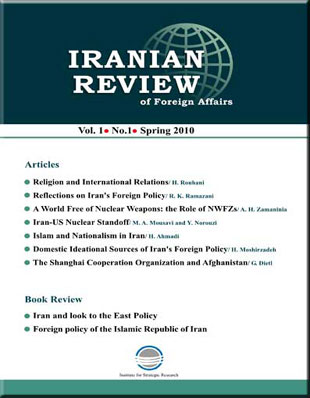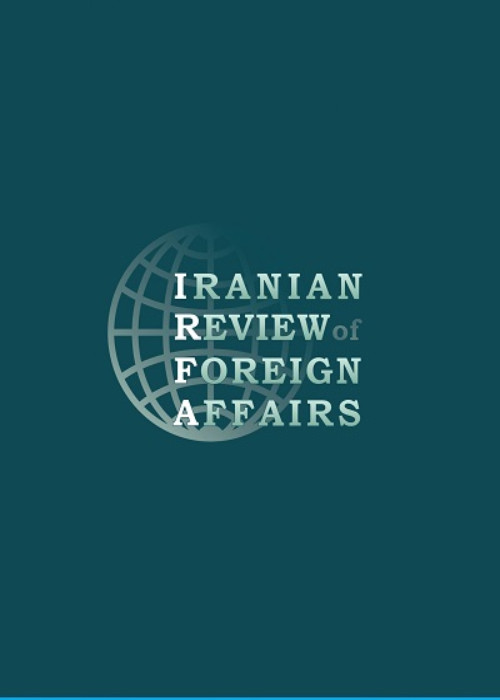فهرست مطالب

Iranian Review of Foreign Affairs
Volume:1 Issue: 1, Spring 2010
- تاریخ انتشار: 1389/03/20
- تعداد عناوین: 10
-
Page 9
-
Page 15The dominant perception in the 19th and 20th centuries seemed to indicate that the march of modernity would lead to the marginalization of the role of religion in the public sphere, including in the realm of politics. Many scholars of international politics and International Relations (IR) have also argued along the same lines. The emergence of a strong counter-trend, a religious-based outlook, since the early decades of the 20th century, especially in the waning decades of the century, appeared to challenge that seemingly entrenched conviction. The establishment of the Islamic Republic of Iran in 1979 – as full-fledged religious state – served as the climax of that counter-trend with significant implications and repercussions, for the region, for the Muslim world, and also for international relations. The present essay is an attempt to look into these issues. It will be argued that the new religious counter-trend, particularly the revival of Islam, represents a process across the Islamic world geared to the preservation and revival of the Islamic identity, and also relying on Islam and its teaching to shape and guide governance in Muslim lands. The essay will also try to have a look at some of the challenges involved in the process; that is, the challenges Islamic governance will face in dealing with others – the dominant secular international system and its components
-
Page 53The present essay argues that Iran’s foreign policy since the 1979 Revolution has pursued an overall aspirational paradigm which I call “spiritual pragmatic”, embodying two seemingly conflicting elements – spirituality and pragmatism. It is also suggested that this hybrid approach to foreign policy is nothing new to Iran; rather, in fact, it dates as far back as ancient pre-Islamic Persia, and more recently, since the reign of the Safavids in the 16th century. The crux of the argument here is to try to dispel the rather cliché images of the post-revolutionary Iranian foreign policy as either “irrational”, “paranoid” or something of that sort or order.The essay will try to trace the examples of the suggested overall approach since the very early days of the Revolution, under the late Ayatollah Khomeini, and subsequently under Ayatollah Khamenei, and during various administrations all through the past three decades. To elucidate the discussion, two specific issues – examples – have been given particular emphasis – the nuclear dossier and the Iran-US relations. The latter, even if strained thus far and with somewhat bleak prospects currently, will have to undergo positive, mutually beneficial change in the future, which as argued in the paper, will have to move beyond misperceptions and more importantly, will require recognition on the US part of Iran’s genuine, long-term national concerns and sensitivities. The essay also touches, in very broad terms, on the still unfolding situation in Iran and addresses the requirements for smooth transformation in its governance in the future.The essay has been authored with the hope of helping to create a better understanding of Iran’s foreign policymaking - in the West in general and the in United States in particular.
-
Page 89The idea of establishing a Weapons of Mass Destruction or Nuclear Weapon Free Zone in the Middle East is not new; it dates back to 1970’s. However, the security landscape of the Middle East today has compelled most analysts to look at the idea and the concept anew. Most regard the potential arms race in the Middle East to seriously jeopardize the prospects for long term stability and balance of power in the region. Israel, Iran and Egypt seem to have the main regional role in making or breaking this idea for another forty years. The absence of real progress in the Arab-Israeli conflict and the hesitant international expectation to make some movements in that front, as well as Iran’s nuclear program being considered at the UN Security Council, where Iran is being practically considered guilty until proven innocent, may offer a window of opportunity to creative thinking and planning for advancing the idea of Weapons of Mass Destruction Free Zone in the Middle East.
-
Page 121For almost three decades since the Iranian Revolution of 1979, there has consistently been a conflict between Iran and the United States over a host of issues. The relations between the two countries became more challenging since 2003 after it came to light that Iran had been developing its nuclear program. Since then some US officials have even gone so far as to announce - and repeat - the possibility of a military strike against Iranian facilities to end the nuclear program. In reality, up to now no such drastic action has taken place. Rather instead, in a milder reaction, the US, aided by its European allies and enjoying Russian and Chinese lukewarm acquiescence, has imposed several rounds of sanctions against Iran through the adoption of obligatory resolutions by the United Nations Security Council. But, these actions have failed to force the Iranians to end their program. As a result, many experts argue that a new policy should be pursued toward Iran vis-à-vis its nuclear dossier. So the main challenge which poses itself is to predict when and how this conflict will come to an end. In this paper, different game theory models are used to interpret the current situation of the crisis. It is shown that while at each step it may be more favorable for each party to insist on its claims, the overall result of this approach may not be so favorable for all. As a result, both parties should think about the long term effects of their decisions. It is also shown that the absence of mutual trust could be the main factor that has forced both sides to reach the current point of crisis. Therefore, any attempt towards re-establishing mutual trust between the two governments might be a major step leading to a lasting solution. Furthermore, different possible choices for the US government and the long term effects of each choice will be analyzed. The analysis will also address economic aspects of the conflict, and the long-term effects of any decision and the best possible choices for both governments will be presented.
-
Page 153Iranian foreign policy during the post-revolutionary period has often been described as pursuing ideological objectives and means. Given the problems usually associated with the concept of ideology, the alternative concept of “domestic ideational sources” would offer a broader perspective and prove less problematic. By this concept is meant the totality of ideas, norms, rules, and discourses that in their inter-relations make the material life meaningful. The basic conceptual and theoretical aspects of the role of ideas and domestic ideational sources in foreign policy - in general and with particular emphasis on the realist outlook – are discussed in the first part of the article. Based on this brief theoretical expose, the article will attempt to look into - and clarify – the main – Islamic- Shi’ite -- components of the domestic ideational sources of Iranian foreign policy since 1979. It will be argued that basic Islamic-Shi’ite ideas; the Iranian encounter with and experience of the West during the 19th and 20th centuries; Iranian intellectuals'' response to the West''s challenge manifested in a kind of Occidentalist discourse; and Western counter hegemonic, leftist and anti-imperialist discourses; have all played a role in shaping and/or affecting Iran’s Islamic revolutionary discourse. Furthermore, the discussion will also show how the discourse of the international system (or international ideational structure), have affected the Islamic discourse, which has led in turn to a variety of interpretations of domestic rules and norms. It will as well be argued that in the process of interaction some extra-religious ideas/discourses and events/experiences have influenced the formation of some versions of the Islamic discourse.
-
Page 193The importance of national identity and national feelings in contemporary Iranian politics has been much neglected by the students of Iranian studies, particularly outside Iran. The establishment of the Islamic Republic of Iran and the dominance of Islamically-oriented policies in its foreign policy seem to have encouraged many to believe that Islam and Iran in the contemporary context are two mutually exclusive factors. However, recent internal developments such as the presidential election, on the one hand, and the firm position of Iranians inside and outside the country toward regional political and international cultural challenges vis-à-vis their national heritage on the other indicate that Iranians consider both the religious and national dimensions of their identity as important, and they consider the relation between religion and nationality as mutually inclusive, as opposed to an exclusive one. This article, focusing on the issue of Islam and nationalism and their relationships, tries to highlight this important factor in order to arrive at a better understanding of the political dynamics of Iranian society and politics. It argues that contrary to the situation in the Arab world, these two elements are both constitutive factors of the Iranian identity. Following a rather brief theoretical discussion of the relations between the two in Islamic and Middle Eastern perspectives, the author will try to explain the political reasons behind the rise of the Islam-nationalism controversy in contemporary Iranian politics and emphasizes that such a dichotomous discourse has an elite rather than popular basis. The concluding section of the article concentrates on the importance of the national factor in the Iranian society by focusing on the two recent presidential elections in Iran as well as on several external political and cultural challenges to Iranian national heritage toward which Iranians took a coherent stance inside and outside of Iran.
-
Page 223The Shanghai Cooperation Organization (SCO) was formed to achieve twinObjectivesto counter and contain the US influence in Eurasia and to balance the Russian and Chinese influence within a multilateral group in that space. Since its inception, the “three evils” of terrorism, separatism and extremism have been at the core of its concerns and activities. Afghanistan, therefore, has been a virtual test-case of its commitment and the raison d’etre of its existence. It is also the first ever “Out of Area” operation that it has undertaken. Committing itself to the Afghan issue is going beyond its mandate; not to have done so would have undermined its very credibility. Its “Out of Area” mission is modeled on the NATO example and has been duly acknowledged by NATO. Like any other regional organisation, it suffers from internal divisions and disunity. And like the rest of the world, it recognises the perils of an unstable Afghanistan. To that extent, it shares a common goal with the US that neither of them can achieve alone. It remains to be seen whether SCO’s recognition of a common goal and working towards it with the US will lead to a transcendence of its own ultimate objective of containment and eventual rollback of the US from its strategic neighbourhood.


